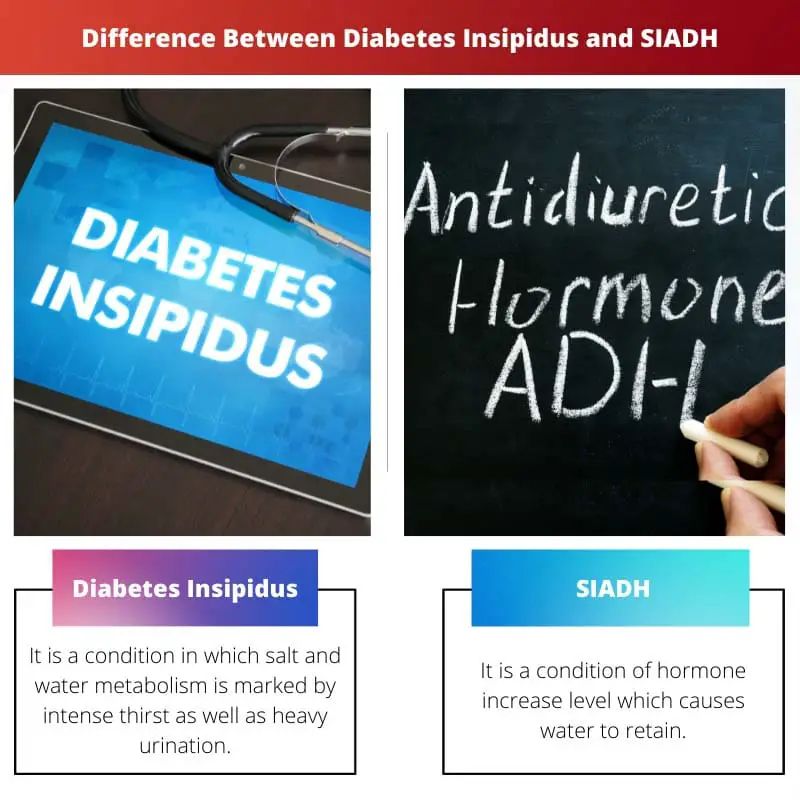In the body, the role of the regulation of levels of water is to the kidney. In case of dehydration, they conserve water, and to expel excess water, they can make urine.
Also, through the skin surface, evaporation takes place, which causes loss of water without even overt sweating.
Sometimes imbalance of water regulation leads to disorders like DI or diabetes insipidus and SIADH or syndrome of inappropriate antidiuretic hormone secretion.
These disorders directly impact the activity or release of ADH. In this article, the main focus is on differentiating diabetes insipidus and SIADH.
Key Takeaways
- Diabetes insipidus is characterized by excessive urination and thirst due to the body’s inability to retain water. At the same time, SIADH (Syndrome of Inappropriate Antidiuretic Hormone) involves excessive water retention and low sodium levels.
- Diabetes insipidus results from a lack of antidiuretic hormone (ADH) or insensitivity to ADH, while SIADH is caused by excessive ADH production.
- Treatment for diabetes insipidus may include hormone replacement therapy, while SIADH treatment involves fluid restriction and addressing the underlying cause.
Diabetes Insipidus vs SIADH
Diabetes insipidus is caused by a deficiency in antidiuretic hormone (ADH), resulting in excessive urine production and thirst, and treatment involves replacing the deficient ADH. SIADH involves an excess of ADH, causing the body to retain water and leading to low sodium levels.

Among the rare disorders, diabetes insipidus is one of them, which causes too much making of urine.
Per day it is common to make 1 to 3 quarts of urine, but people with diabetes insipidus can make urine a day up to 20 quarts. This disorder makes people two frequently urinate.
The abbreviation for the syndrome of inappropriate antidiuretic hormone secretion is SIADH. It involves the continued action or secretion of AVP or arginine vasopressin despite increased or normal plasma volume.
The resulting water secretion impairment and consequent water retention produce hyponatremia.
Comparison Table
| Parameters of Comparison | Diabetes Insipidus | SIADH |
|---|---|---|
| Interpretation | It is a condition in which salt and water metabolism is marked by intense thirst as well as heavy urination. | It is a condition of hormone increase level which causes water to retain. |
| Sodium content | High | Low |
| ADH | Inadequate | Excess |
| Plasma volume | Euvolemic | Slightly hypervolemic or euvolemic |
| Risk | Hypovolemic shock | Seizures |
What is Diabetes Insipidus?
Diabetes insipidus is one of the uncommon disorders that causes the body an imbalance of fluids. This imbalance results from the production of urine in mainly large amounts.
Even if the person has something to drink but still makes the patient very thirsty, diabetes insipidus is sometimes confused with diabetes mellitus because they sound similar.
Meanwhile, diabetes mellitus is a completely different disorder that is common and involves a high level of blood sugar. Diabetes insipidus has no cure, but treatment can relieve thirst, prevent dehydration, and decrease urine output.
It occurs when the body fails to balance the fluid levels properly.
Sometimes, for diabetes insipidus, there is no particular cause. But in some people, the result might be due to an autoimmune reaction that damages cells due to the immune system that makes vasopressin.
Dehydration can be led by diabetes insipidus, which can be caused by dry mouth, fatigue, and thirst.
Nephrogenic diabetes insipidus shortly after or present at birth has a genetic cause that can permanently change the kidney’s ability to the urine concentration.
It affects males, but genes can be passed to children by women.
What is SIADH?
ADH or anti-diuretic hormone is specifically produced by the hypothalamus which is an area of the brain.
This hormone is released and stored by the gland, namely, the pituitary. The main goal of ADH is to control how the body conserves or releases water.
When in excess amount, the ADH is released this condition is known as SIADH or simply syndrome of inappropriate antidiuretic hormone. This condition makes it harder for water to be released by the body.
Additionally, SIADH causes electrolyte levels, like sodium, to fall due to water retention.
Hyponatremia, or simply low sodium level, is SIADH’s major complication and is responsible for various SIADH symptoms.
When it comes to early symptoms, its symptoms might be mild and consist of vomiting, cramping, and nausea.
SIADH can also cause coma, confusion, and seizures in many severe cases.
Treatment begins with fluid intake in a limited amount to prevent its buildup in further amounts. Depending on the causes, its additional treatment relies on.
Main Differences Between Diabetes Insipidus and SIADH
- Diabetes insipidus can be classified into NDI or nephrogenic diabetes insipidus and CDI or cranial diabetes insipidus. Conversely, SIADH can be classified into Type D SIADH, Type B SIADH, Type C SIADH, and Type A SIADH.
- The causes of diabetes insipidus are brain damage due to stroke, complications during pituitary surgery, and drugs like Declomycin. On the other hand, adrenal insufficiency, mental status changes, and pulmonary disease are causes of SIADH.
- These symptoms of diabetes insipidus are cold drinks, cravings, too much thirst, huge diluted urine production, and increased urge to pee during the night. Meanwhile, seizures, vomiting, irritability, and memory impairment are SIADH symptoms.
- Tests included in diabetes insipidus diagnosis are a water deprivation test, physical examination, urine analysis, and electrolyte levels assessment. In contrast, biochemistry tests, serum osmolality, early morning cortisol level, and thyroid function tests are tests included in SIADH diagnosis.
- When it comes to treatment, diabetes insipidus can be treated with HCTZ, vasopressin, and chlorpropamide. On the flip side, SIADH can be treated with demeclocycline, fluid restriction, and normal saline.




